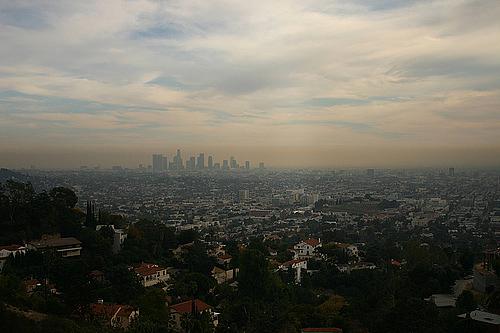Health Effects of Bad Air

In the course of researching my book, FEVERED, I traveled to California’s Central Valley -- the agricultural heartland where roughly a quarter of the fruits and vegetables America eats are grown. The entire time I was there, I felt like I was fighting off a cold because the dirty air irritated my throat and stung my eyes. Locals told me that on hot days, the toxic smog that envelops the entire valley in a blanket of haze sends kids who can’t breathe to hospital emergency rooms and doctors’ office.
For Californians who live, work and breathe in the state’s industrial zones, like the Central Valley, the health effects they experience from pollution are a preview of what’s likely to happen to all of us as the planet gets hotter, carbon levels climb and air quality steadily worsens, resulting in higher rates of asthma, allergies, respiratory ills and even heart disease.
Already, the heat-trapping carbon dioxide that’s emitted from tailpipes and factories collects over cities, creating CO2 “domes” that shroud the urban cores in toxic clouds of pollutants. In cities like New York, Phoenix and Baltimore, ambient CO2 parts per million (ppm) levels can spike into the 400s, 500s, and 600s, the potential norm in the coming decades, according to climate models. A 2010 Stanford University study found that these domes exacerbate pollution’s harmful health effects, and may cause 1,000 deaths a year.
Sunbelt cities like Los Angeles, Riverside, California, and Houston, with their seemingly endless sunny days, gridlocked urban sprawl and heat-trapping stagnant air masses that squat over the metropolitan areas, contain the highest average concentrations of ozone, according to a 2009 study by UC Berkeley scientists. The same research demonstrated that people living in these regions, and in California’s Central Valley, have a 25 to 30 percent greater annual risk of dying from respiratory diseases, like pneumonia and chronic obstructive pulmonary disease, compared to residents who enjoyed cleaner air in places like San Francisco and Seattle where fog, rain and cooler weather keeps ozone levels in check.
Global warming stands to exacerbate the problem. Two of the chief culprits behind asthma, allergies and respiratory illnesses -- air pollution and smog -- intensify as temperatures rise. Ozone smog is a mixture of all the pollutants and particles in the air that are emitted by factories, and the gases belched from vehicle tailpipes. It is created by a chemical reaction sparked when sunlight cooks these pollutants in the atmosphere. As the air heats up, more ozone is produced, and more ozone in turn traps more heat.
This worsens the urban heat island effect -- when cities are anywhere from five to ten degrees hotter than surrounding areas because buildings and asphalt retain and radiate heat -- and creates a self perpetuating feedback loop. In fact, a 2009 study done by a team of European scientists looked at hospital admission data from 12 major cities, including Dublin, London, Barcelona, Athens and Rome, over a three-year period. They found that for every one degree Celsius (about 2 degrees Fahrenheit) of temperature increase, hospitalizations from respiratory and asthma related illness rise by 4.5 percent.
Children may be the ones who suffer the most, according to the results of a long-term USC study on the link between chronic exposure to air pollution from freeway traffic and respiratory illnesses. Called The USC Children’s Health Study, the research project began in 1993 and eventually involved about 5,500 children in twelve communities in southern California. Two-thirds of them were enrolled as fourth graders, and they were all followed until they graduated from high school.
After a decade of meticulous monitoring, the USC researchers found that the development of the lungs of children who lived near highly trafficked corridors was stunted, about 20% smaller than normal, which greatly impaired their normal functioning. These youngsters also were at a significantly higher asthma risk -- those living within a quarter of a mile from a freeway had an 89 percent higher risk of asthma than kids more than a mile away. Additionally, their asthma symptoms were worse, and their odds of ending up in the hospital emergency choking from the bad air was triple that of youngsters in low-traffic areas, even if they had health insurance. Worse yet, pregnant women living in these highly trafficked areas were more likely to give birth to premature or low birth weight infants, which set-up the next generation for the potential of disabilities and developmental deficits.
“What we’re seeing now is probably just the beginning of the effects we’ll experience from bad air,” Dr. Jose Joseph, a pulmonologist and asthma specialist at UCSF-Fresno, told me when I interviewed him for my book.
“In the years to come, we’re going to have major increases in all types of chronic illnesses,” he continued, ticking them off on his fingers. “In respiratory illnesses, in heart disease, in increases in heart attacks and strokes because air pollution increases blood clotting, and in its effects on developing fetuses -- there is so much fallout from air pollution. In looking at the magnitude of the problem, we really have to do better than this.”
Linda Marsa's book FEVERED is now available wherever books and e-books are sold.
Image by Steven Buss via Flickr

